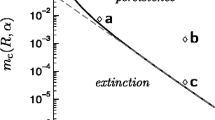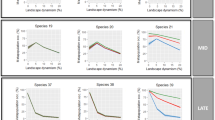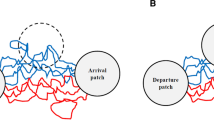Abstract
The role of spatial configuration for metapopulation survival is analyzed by using a stochastic metapopulation model. This model reveals conditions which must be satisfied by the species' ecology and the landscape settings before a metapopulation can persist over a long term. Taking this as a basis, initial rules of thumb for landscape management are deduced. The following results are highlighted: (1) the critical correlation length dc of the extinction processes determines a spatial scale of the metapopulation dynamics. (2) Only species with a dispersal range dr above the correlation length dc are able to benefit from landscape management at all. (3) A certain metapopulation can only persist over a long term if no patch is inside the range of correlation of another one. (4) There is a hierarchy of importance in the characteristics of a spatial configuration (scale and type) and, hence, in the scopes of landscape management. To conclude, some general consequences for supporting species survival by management are discussed. Some prospects concerning the use of models for decision support in landscape planning are discussed.
Similar content being viewed by others
References
Baars, M.A. and van Dijk, T.H. (1984). Population dynamics of two carabid beetles at a Dutch heathland. I. Subpopulation fluctuations in relation to weather and dispersal. J. Animal Ecology 53: 375-388.
den Boer, P.J. 1981. On the survival of populations in a heterogeneous and variable environment. Oecologia (Berlin) 50: 39-53.
Doak, D.F. and Mills, L.S. 1994. A useful role for theory in conservation. Ecology 75: 615-626.
Drechsler, M. and Wissel, C. 1997. Separability of local and regional dynamics in metapopulations. Theor. Popul. Biol. 51: 9-21.
Errington, P.L. 1946. Predation and vertebrate populations. Q. Rev. Biol. 41: 315-336.
Fischer, S., Poschlod, P. and Beinlich, B. (1996). Experimental studies on the dispersal of plants and animals by sheep in calcareous grasslands. Journal of Applied Ecology (in press).
Frank, K., Drechsler, M. and Wissel, C. 1994. Ñberleben in fragmentierten Lebensräumen – Stochastische Modelle zu Metapopulationen. Z. Ökologie Naturschutz 3: 167-178.
Gilpin, M. 1990. Extinction of finite metapopulations in correlated environments. In Living in a Patchy Environment. pp. 177-186. Edited by B. Shorocks. Oxford University Press, Oxford.
Goodman, D. 1987. The demography of chance extinction. In Viable Populations for Conservation. pp. 11-34. Edited by M.E. Soulè. Cambridge University Press, Cambridge.
Gottschalk, E. 1996. Population vulnerability of the Grey Bush cricket Platycleis albopunctata (Goeze, 1778) (Ensifera: Tettigoniidae). In Species Survival in Fragmented Landscapes. pp. 324-328. Edited by J. Settele, C.R. Margules, P. Poschlod and K. Henle. Kluwer Academic Publishers, The Netherlands.
Grimm, V., Frank, K., Jeltsch, F., Brandl, R., Uchmanski, J. and Wissel, C. 1996. Pattern-oriented modelling in population ecology. Science of the Total Environment 183: 151-166.
Gyllenberg, M. and Silvestrov, D.S. (1994). Quasi-stationary distributions of a stochastic metapopulation model. J. Math. Biol. 33: 35-70.
Hanski, I. 1991. Single-species metapopulation dynamics: concepts, models and observations. Biol. J. Linnean Society 42: 17-38.
Hanski, I. 1994. A practical model of metapopulation dynamics. J. Anim. Ecol. 63: 151-162.
Harrison, S., Murphy, D.D. and Ehrlich, P.R. 1988. Distribution of the Bay Checkerspot Butterfly, Euphydryas editha bayensis. Evidence for a metapopulation model. Am. Nat. 132: 360-382.
Harrison, S. and Quinn, J.F. 1989. Correlated environments and the persistence of metapopulations. Oikos 56: 1-6.
Kalkhoven, J.T.R. 1995. Application of knowledge on fragmentation in planning.In Principles and tools for the study of landscape ecology-potentials and limitations. Proceedings of the Second CONNECT Workshop in Landscape Ecology 1993 (NERI Technical Report No. 131). pp. 98-100. Edited by F. Skov, J. Komdeur, G. Fry and J. Knudsen. National Environmental Research Institute.
Kareiva, P. and Shigesada, N. 1983. Analyzing insect movement as a correlated random walk. Oecologia (Berlin) 56: 234-238.
Lefkovitch, L.P. and Fahrig, L. 1985. Spatial characteristics of habitat patches and population survival. Ecol. Modelling 30: 297-308.
Levin, S.A. (1992). The problem of pattern and scale in ecology. Ecology. 73: 1943-1967.
Levins, R. 1969. Some demographic and genetic consequences of environmental heterogeneity for biological control. Bull. Entomol. Soc. America 15: 237-240.
Moloney, K.A. 1993. Determining process through pattern: reality or fantasy. In Patch Dynamics (Lecture Notes in Biomathematics 96). pp. 61-69. Edited by S.A. Levin, T.M. Powell and J.H. Steele. Springer-Verlag, Berlin.
Nagylaki, T., Keenan, P.T. and Dupont, T.F. (1993). The influence of spatial inhomogeneities on neutral models of geographical variation, III. Migration across a geographical barrier. Theor. Pop. Biology. 43: 217-249.
Nisbet, R.M. and Gurney, W.S.C. 1982. Modelling Fluctuating Populations. Wiley, New York.
Poschlod, P., Bakker, J., Bonn, S. and Fischer, S. (1996). Dispersal of plants in fragmented landscapes. In Species Survival in Fragmented Landscapes. pp. 123-127. Edited by J. Settele, C.R. Margules, P. Poschlod and K. Henle. Kluwer Academic Publishers, The Netherlands.
Quinn, J.F. and Hastings, A. 1987. Extinction in subdivided habitats. Conservation Biology 1: 198-208.
Schippers, P., Verboom, J., Knapen, J.P. and van Apeldoorn, R.C. 1996. Dispersal and habitat connectivity in complex heterogeneous landscapes: an analysis with a GIS-based random walk model. Ecography 19: 97-106.
Schumaker, N.H. 1996. Using landscape indices to predict habitatconnectivity. Ecology. 77: 1210-1225.
Settele, S. and Geißler, S. 1988. Schutz des vom Aussterben bedrohten Blauschwarzen Moorbläulings durch Brachenerhalt, Grabenpflege und Biotopverbund im Filderraum. Natur und Landschaft 11: 467-470.
Sisk, T.D. and Margules, C.R. 1993. Habitat edges and restoration: methods for quantifying edge effects and prediciting the results of restoration efforts. In Reconstruction of Fragmented Ecosystems (Nature Conservation 3). pp. 57-69. Edited by D.A. Saunders, R.J. Hobbs and P.R. Ehrlich. Sarrey Beatty & Sons.
Stelter, C., Reich, M., Grimm, V. and Wissel, C. 1997. Modelling persistence in dynamic landscapes: lessons from a metapopulation of the grasshopper Bryodema tuberculata. J. Animal Ecology 66: 508-518.
Tischendorf, L. 1997. Modelling individual movements in heterogeneous landscapes: potentials of a new approach. Ecological Modelling (in press).
Tischendorf, L. and Wissel, C. 1997. Corridors as conduits for small animals: Attainable distances depending on movement pattern, boundary reaction and corridor width. Oikos 79: 603-611.
Verboom, J., Lankester, K. and Metz, J.A.J. 1991. Linking local and regional dynamics in stochastic metapopulation models. Biol. J. Linnean Society 42: 39-55.
Verboom, J., Metz, J. and Meelis, E. 1993. Metapopulation models for impact assessment of fragmentation. In Landscape Ecology of a Stressed Environment. (IALE Studies in Landscape Ecology 1). pp. 172-191. Edited by C.C. Vos and P. Opdam. Chapman & Hall, London.
Weaver, J.L., Paquet, P.C. and Ruggiero, L.F. 1996. Resilience and conservation of large carnivores in the Rocky Mountains. Conservation Biology 10: 964-976.
Wilcove, D.S., McLennan, C.H. and Dobson, A.P. 1986. Habitat-fragmentation in the temperate zone. In Conservation Biology. pp. 237-256. Edited by M.E. Soulè, Sinauer, Sunderland.
Wilson G.G. and Willis, E.O. 1975. Applied biogeography. In Ecology and Evolution of Communities. pp. 523-534. Edited by M.L. Cody and J.M. Diamond. Harvard University Press, Cambridge, MA.
Wissel, C., Stephan, Th., and Zaschke, S.-H. 1994. Modelling extinction of small populations. In Minimum viable populations. (Ecol. Studies 106). pp. 67-103. Edited by H. Remmert. Springer, Heidelberg-Berlin.
Wolfram, S. 1992. Mathematica-A System for Doing Mathematics by Computer. Addison-Wesley Publishing Company (Germany). 993 pp.
Author information
Authors and Affiliations
Rights and permissions
About this article
Cite this article
Frank, K., Wissel, C. Spatial aspects of metapopulation survival – from model results to rules of thumb for landscape management. Landscape Ecology 13, 363–379 (1998). https://doi.org/10.1023/A:1008054906030
Issue Date:
DOI: https://doi.org/10.1023/A:1008054906030




